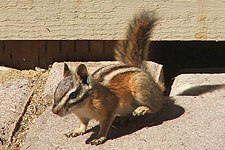Local Wildlife
Yellow Pine Chipmunk

Scientific Name: Tamias amoenus
More Info: Univ. of Michigan
Yellow pine chipmunks are easily recognized by the light and dark stripes on their backs and heads. Like most chipmunks, they are quite vocal with cries that are often mistaken for those of other animals. These chipmunks have home ranges that overlap broadly, but they are not territorial in the conventional sense. Instead, each has its own burrow and generally ignores others of its species.
Most common in brushy, coniferous forests, yellow pine chipmunks can be found in a wide range of habitats including rocky outcrops, chaparral, and meadows. They generally occupy areas that are dominated by shrubs and require logs, snags, rock crevices, or stumps for nesting. In Sunriver you can find them anywhere there are trees and logs, but especially on and around several of the large rock outcroppings which provide a lookout for predators, places to store food and to hide, and warmth (as the rocks hold heat from the sun).
Much of the chipmunk's day is spent collecting and storing its primary source of food...seeds. Most foraging occurs on the ground in areas where there are enough rocks, fallen limbs, and other object to provide protection from predators (though they easily climb trees and shrubs to harvest nuts and fruit). Food collected is stored in the burrow or buried in shallow holes dug for this purpose. When food is scarce, they may also eat young leaves and shoots, insects, earthworms, flowers, and berries.
Breeding occurs once per year during late April to early May and litters average three to eight babies. Young remain in the burrow until they are weaned at six weeks of age. They begin to leave and find their own burrows between 8 and 12 weeks of age.
